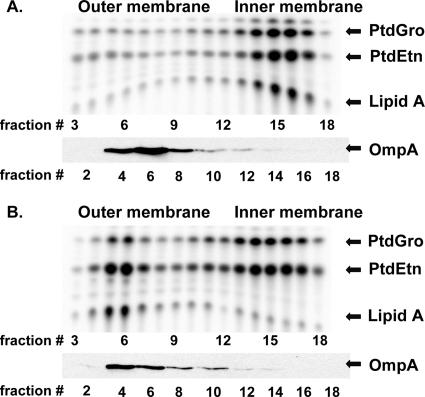FIG. 3.
Accumulation of newly synthesized lipids in the inner membrane of Lud002 (MsbAS168L). Lud002 cells harboring vector pWSK29 (A) or pWTD10 (B) were grown at 30°C to late log phase in LB-ampicillin and then diluted 1:3 into fresh media that had been prewarmed to 44°C. Growth was continued at this temperature for 40 min with 2.5 μCi/ml 32Pi added during the final 10 min of growth. Cells were recovered by centrifugation, and spheroplasts were prepared by treatment with EDTA-lysozyme and lysed by sonication. Washed membranes were separated into IM and OM fractions by use of a 30-to-60% sucrose gradient (6, 21). Portions of gradient fractions were subjected to mild acid hydrolysis, and lipids were extracted with organic solvents as described previously (6, 37). This treatment has no effect on phospholipids and allows the LPS and phospholipids to be analyzed simultaneously. Lipid species were resolved by thin-layer chromatography using the solvent chloroform:pyridine:88% formic acid:water (50:50:16:5) and analyzed using a PhosphorImager equipped with IQMac software. Fractions were analyzed by Western blotting using an anti-proOmpA polyclonal antibody to identify OM fractions as described previously (8). Abbreviations: PtdGro, phosphatidylglycerol; PtdEtn, phosphatidylethanolamine.

